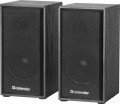Frequency range
The range of audio frequencies supported by acoustics. The wider this range — the fuller the reproduced sound, the lower the likelihood that some of these details at low or high frequencies will remain “behind the scenes”. At the same time, the human ear is able to hear frequencies of the order of 16 – 22,000 Hz, and with age, this range narrows even more. In modern audio equipment, especially at the top level, there may be more extensive ranges, but from a practical point of view, this does not make much sense. In addition, it is worth noting that a wide frequency range in itself does not guarantee high-quality sound — a lot also depends on the frequency response.
Volume control
The location of the own volume control provided in the speakers. In modern computer speakers, there are regulators installed in the
front,
back,
side,
top,
on the signal cable, on the amplifier and on the remote control (the latter can be either the only regulator or in addition to the regulator with a different location; see below for details). Here are the features of each option:
— Front. The most popular arrangement nowadays: the front panel of the speaker is the easiest to reach, the regulator can be twisted at any time without any problems, and even if the speakers are tightly surrounded by foreign objects from the back and sides, the front panel usually remains free. Of the shortcomings, one can only note the moment that not everyone likes the extra handles on the front panel of the speaker — however, this is a purely aesthetic nuance that does not affect convenience.
— Behind. The knob mounted on the rear panel of the speaker is not very convenient for frequent volume changes — you usually have to find it by touch, and some free space around the speaker is required to access it. So on such speakers it is most convenient to initially select a certain optimal sound level, and then, if necessary, adjust the volume through the computer's software settings and not reach out to the regul
...ator once again. Therefore, this option is quite rare. On the other hand, such invisibility has its advantages: acoustics acquires the most accurate appearance, without unnecessary small elements on the outside.
— Sideways. A kind of compromise between the two options described above: the regulator is not as noticeable as the front one, and at the same time it is easier to get to it than the rear one. However there should be enough free space on the corresponding side of the speaker for this, but this drawback is not particularly critical. So the lateral arrangement is found, although less often than the anterior one, but noticeably more often than the posterior one.
— Above. Pretty specific option. In terms of general specifics, it is similar to the side arrangement described above, however, for a number of reasons it is extremely rare — in speakers of non-standard design, as well as in some sets in which the system control is located on the subwoofer (this component is often installed on the floor, and the top position of the regulator is the most convenient).
— On the signal cable. A regulator placed directly on the wire carrying the audio signal. It is used mainly in inexpensive compact speakers: it is easier and cheaper to install a regulator in this way than to build it into a case, and the dimensions of the case itself can be reduced due to the absence of “extra” parts inside.
— On the amplifier. Option for models with external amplifier (see above). It is the parameters of the amplifier that determine the volume of the sound, so it is more logical to place the volume control on it, and not on one of the speakers. Theoretically, the specific location of the regulator can be different; in fact, this knob (like other controls) is usually mounted on the front panel. Note that such equipment is often supplemented by a regulator on the remote control (see below) — the amplifier is not always conveniently located, for frequent adjustments it is more convenient to use the remote control.
— On the remote control. The controller mounted on the remote control — this can be either a wired or wireless accessory (see "Remote control"). Actually, the presence of a remote control is almost guaranteed to mean the presence of a volume control in it, exceptions are extremely rare; and if there are two such consoles (wired and wireless), then the regulators are often installed in both. Also note that volume control from the remote control can be supplemented by a knob located in any of the places described above (except for the signal cable).
